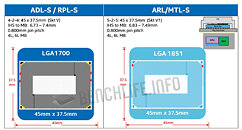
Intel Unveils "Arrow Lake" for Desktops, "Lunar Lake" for Mobile, Coming This Year
Intel in its 2024 International CES presentation, unveiled its two new upcoming client microarchitectures, "Arrow Lake" and "Lunar Lake." Michelle Johnston Holthaus, EVP and GM of Intel's client computing group (CCG), in her keynote address, held up a next-generation Core Ultra "Lunar Lake" chip. This is the Lunar Lake-MX package, with MOP (memory on package). You have a Foveros base tile resembling "Meteor Lake," with on-package LPDDR5x memory stacks. With "Lunar Lake," Intel is reorganizing components across its various Foveros tiles—the Compute and Graphics tiles are combined into a single tile built on an Intel foundry node that's possibly the Intel 20A (we have no confirmation); and a smaller SoC tile that has all of the components of the current "Meteor Lake" SoC tile, and is possibly built on a TSMC node, such as N3.
"Lunar Lake" will pick up the mantle from "Meteor Lake" in the U-segment and H-segment (that's ultraportables, and thin-and-light), when it comes out later this year (we predict in the second half of 2024), with Core Ultra 2-series branding. Intel also referenced "Arrow Lake," which could finally bring light to the sluggish pace of development in its desktop segment. When it comes out later this year, "Arrow Lake" will debut Socket LGA1851, "Arrow Lake" will bring the AI Boost NPU to the desktop, along with Arc Xe-LPG integrated graphics. The biggest upgrade of course will be its new Compute tile, with its "Lion Cove" P-cores, and "Skymont" E-cores, that possibly offer a large IPC uplift over the current combination of "Raptor Cove" and "Gracemont" cores on the "Raptor Lake" silicon. It's also possible that Intel will try to bring "Meteor Lake" with its 6P+8E Compute tile, Xe-LPG iGPU, and NPU, to the LGA1851 socket, as part of some mid-range processor models. 2024 will see a Intel desktop processor based on a new architecture, which is the big takeaway here.
"Lunar Lake" will pick up the mantle from "Meteor Lake" in the U-segment and H-segment (that's ultraportables, and thin-and-light), when it comes out later this year (we predict in the second half of 2024), with Core Ultra 2-series branding. Intel also referenced "Arrow Lake," which could finally bring light to the sluggish pace of development in its desktop segment. When it comes out later this year, "Arrow Lake" will debut Socket LGA1851, "Arrow Lake" will bring the AI Boost NPU to the desktop, along with Arc Xe-LPG integrated graphics. The biggest upgrade of course will be its new Compute tile, with its "Lion Cove" P-cores, and "Skymont" E-cores, that possibly offer a large IPC uplift over the current combination of "Raptor Cove" and "Gracemont" cores on the "Raptor Lake" silicon. It's also possible that Intel will try to bring "Meteor Lake" with its 6P+8E Compute tile, Xe-LPG iGPU, and NPU, to the LGA1851 socket, as part of some mid-range processor models. 2024 will see a Intel desktop processor based on a new architecture, which is the big takeaway here.













